It’s obvious from my most recent post on Arcadian Rhythms that my mobile gaming has, of late, been of a rather singular stripe. And is there much to say about Puzzle & Dragons that has not already been said? Perhaps those of us here in Europe aren’t quite as familiar with this free title as our Japanese or North American brethren, given that it’s not actually out here, but any of us with at least one friend who’s into mobile gaming will at least have heard the name mentioned.
And yes, it’s very good. The simple match-3 gameplay has been spiced up with a greater degree of mobility than you usually see, meaning that chain combo-making can involve thought rather than hope, and the Pokemon-esque monster collecting and evolving is as impossibly moreish as such mechanics ever are when bolted to compelling gameplay. But that’s about it.
Fortunately, I had been playing some other mobile games before I installed Puzzle & Dragons, so here are a few thoughts on those. If you don’t just play Puzzle & Dragons, you may enjoy some of these.
Asphalt 7: Heat (Android/iOS)
The Asphalt series of handheld/mobile racing games is a solid little earner for French-based mobile giant Gameloft. They’ve made enough of them. The series began on the Nintendo DS and, ahahaha, the Nokia N-Gage and there have been a lot of iterations since then.
Alphalt 7 is the first I’ve played, not being a traditional fan of games for petrolheads or simulated speed freaks, so I’m not sure how the series has evolved over the years, but what I can tell you right now is that Asphalt 7 is basically Burnout on your phone. But not as good. That’s partly because it’s on your phone and partly because it’s not developed by Criterion.
It’s alright, though, especially when you factor in the price. I bought it on a sale for £0.25, which is not enough money to buy a packet of crisps or a bar of chocolate – possibly a bottle of Panda Pop if it was still made. It’s ordinarily priced at a wallet-lacerating £0.69, which is about the price of fifteen second-hand Burnout Paradises, or one second-hand Burnout 2 and a Playstation 2. There’s in-app purchasing, admittedly, but it’s easy to ignore (disclaimer: it may get more obnoxious when you get really far into the game – I can’t see it happening but I wouldn’t rule it out. Hi Gameloft!).
Asphalt 7 defaults to accelerometer control, i.e. you tilt your device to steer your car. How well does that work? Well… not brilliantly. I tend to spend most of my time riding walls, and it’s not even wall riding as ‘elegant’ as we’ve experienced throughout the Burnout series. My cars in Asphalt 7 seem to like grinding their noses into walls whilst still travelling at about eighty miles per hour. The game has anticipated issues with controls by being pretty easy. You can’t coast through a race, even an early one, but you can careen across a stretch of track bouncing from wall to wall for a few seconds before regaining control and not be completely stuffed.
It looks quite nice too, for a fairly bland game about fastfast cars. And you can drift by tapping the left side of the screen, and boost by tapping the right. You upgrade your cars with money. Oh god, I can’t go on talking about this. I think it’s okay! It cost me an eighth of a bus journey! What more do you want from me?!
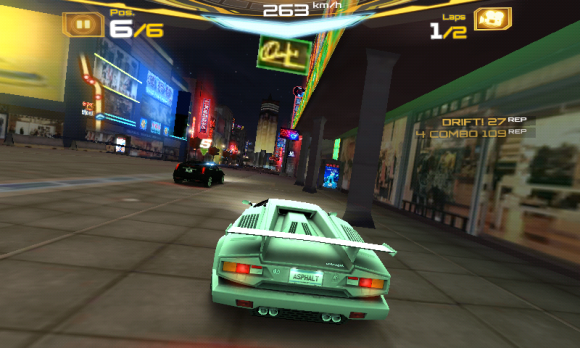
Sector Strike
Sector Strike is what the Drunken Gamers would’ve called a left-rightly shmup; a side-scrolling shooter with enemies emerging from the right. There’s the usual mix of attack patterns; rows of small or medium ships in groups of five or six and making the occasional feint and circle to wrongfoot you, alongside the occasional larger enemy which can take more punishment and throws out projectiles in predictable patterns.
I initially got on well with Sector Strike, enjoying its simple and unchallenging gameplay and the way its overarching upgrade system and in-mission power-up systems complimented one another. It was easy to mess up and die but it felt like my error; for example, stupidly blundering into a row of small ships right after an enemy shot removes your power-ups and renders you vulnerable. Annoying but fair.
Unfortunately the game escalates in difficulty quite quickly, throwing more projectiles on-screen than are easy to dodge with your finger obscuring part of the screen and demanding more currency to upgrade your basic weapons than it’s realistic to collect in one or two levels. Sector Strike’s problems, then, are twofold: firstly that it’s a difficult proposition to play beyond the early levels on a device with a small screen (I’ve not tried it on my 7″ tablet, only on my Galaxy S2), and secondly that its difficulty and cost curves appear designed to encourage microtransaction investment.
In fairness to the game it does offer an alternative control screen which helps with the finger-obscured screen issue, and its microtransaction functionality is entirely inobtrusive, so it does make efforts to tackle two common issues with mobile gaming. Unfortunately it’s still a game I find frustrating to play despite my early enjoyment, and therefore it will likely languish unplayed until I uninstall it.
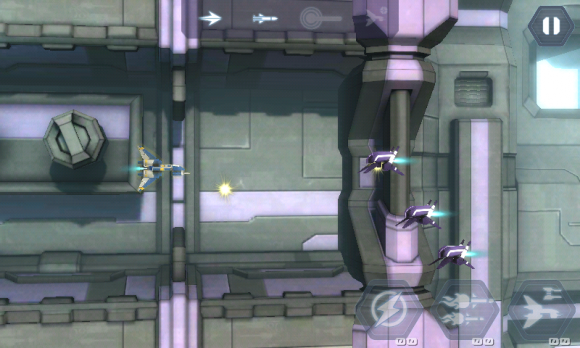
Winter Walk
Sometimes you just don’t have those five minute gaps in your day; the gaps in which the mobile gaming ecosystem takes root and blooms. Sometimes you only have one minute or two. At those times, games like Winter Walk are perfect. It boots in seconds and launches right into the game – no faffing about with menus here.
Gameplay is tremendously simple: you tap on the screen to start a dapper fellow off on his evening consistutional. Your objective is to help him take as many steps as possible before he loses his hat. It’s a grand thing, this chap’s headwear, a towering top hat that indicates he is a gentleman of means and culture. Unfortunately the winds can whip up something fierce and threaten to blow away your hat. Fortunately for him your guidance is at hand: tap and hold on the screen and he’ll grip the brim of his hat tightly.
That’s it. You watch, he walks, you tap, he stops and holds. Along the way he idly ponders this and that, and you can read his thoughts. It’s not as easy as it sounds, though, as it’s easy to misjudge the right moment to grab that hat or when the winds are going to gust, not to mention letting yourself get distracted by his urbane contemplation. Fortunately failure just involves a nearby urchin retrieving his hat and receiving a shiny coin in exchange, after which you can keep on strolling – with the step count reset, of course.
Winter Walk is one of the simplest games I’ve ever played and very charming. It’s fun to fire it up every few weeks and have a crack at beating my last high score. Simple as that.
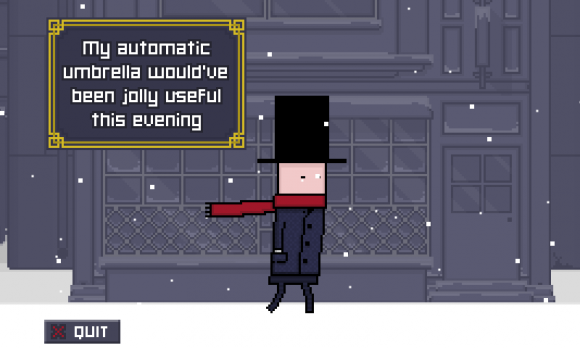
Word Hero & Dropwords
I’ve decided to bundle these two in together as there is a fair bit of common ground between them. Both are wordsearch games in which players must identify words of two or more characters and swipe their fingers across the letters in sequence. Larger words make for higher scores, and certain letters reward more points.
Word Hero is a more openly competitive game, and each two minute game pits you against players of a similar rank (which is determined based on your average score). Each set of tiles is locked to a game, although players can revolve it by 90 degrees each time to gain a new perspective and spot more hidden words. It has an absolutely ludicrous database of words and even a professional in the field of linguistics will probably find themselves surprised by some of what appears in each game.
In fact, once you’ve exhausted all of the words you know and can see in a game, it usually pays dividends to just swipe random three word sequences because these will often be recognised as valid by the game. It’s cheating, sure, but it’s more interesting than watching a timer tick down. I do actually wonder if the database that Word Hero uses has erroneously included a database of acronyms and abbreviations.
Dropwords is also timed, although players can gain additional time by forming lengthy words. However, each tile that is used in a valid word will disappear and new tiles will drop in from the top. This makes Dropwords a more unpredictable experience than Word Hero and less competitive, as players aren’t competing on an entirely level playing field. It also means players are less likely to try and find random words they don’t know, as it’s better to hunt for a decent-sized word that you do know. The downside, of course, is that it’s not as easy to compare yourself against opponents of a similar lexical level.
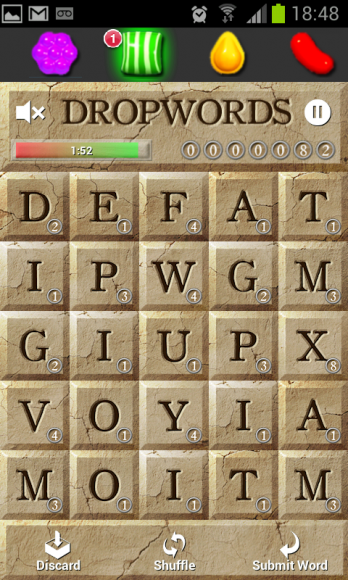
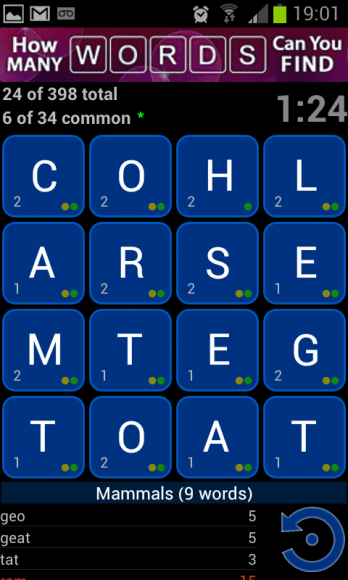
Maya Quest
Maya Quest is barely a game. Look, I know I just wrote about how Winter Walk has pretty much no gameplay, but bear with me. Maya Quest is ostensibly a puzzle game but the puzzle is selecting two things that are the same colour. You need to do this quickly so that you get a better medal for beating a level. You can select two things of the same colour from the main screen, or from a tray of things that you can cycle in when you’re short a thing of a particular colour on the main screen.
Maya Quest is a nothing game. It is simplistic pattern recognition at speed. You will experience no emotion whilst playing Maya Quest. You will experience no curiousity whilst playing Maya Quest. You will experience no excitement whilst playing Maya Quest. You will experience nothing whilst playing Maya Quest.
I got Maya Quest free from an app of the day promotional series I briefly followed. I do not follow it any more. App of the day promotional series should consider exercising some quality control.
If you enjoy Maya Quest, you may be wasting your time with videogames. I suggest a career in filing. Sometimes you may need to cross-reference some paperwork. That is more interesting than Maya Quest, because the paperwork probably says something.

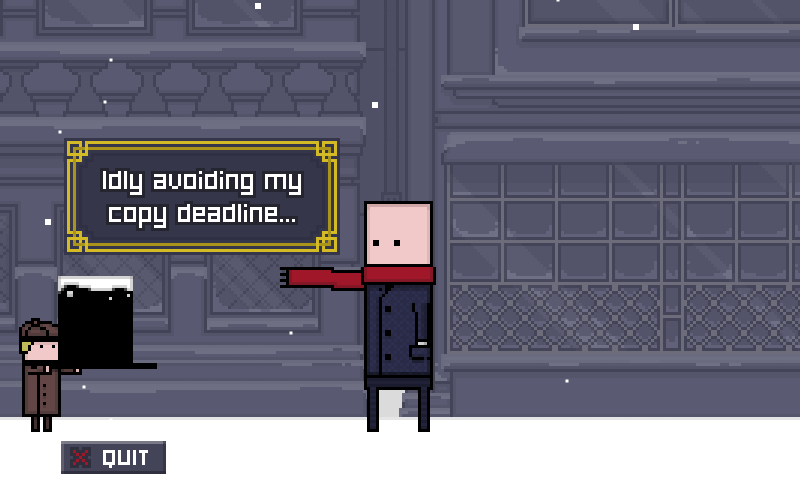
Comments
6 responses to “Mobile Round-up June ’13”
> "more projectiles on-screen than are easy to dodge with your finger obscuring part of the screen"
One of my favourite genres that just can't work on a touchscreen. :(
I'm sure there are ways around this issue – I just wish I knew what they were and which games had found them!
Yeah, Ikaruga was recently (apparently) ported to Android and I heard some say that it was better on a touchscreen. I'm sorry, but sod off. No. It can't possibly be better because your digits obscure too much. Shmups are all about spatial awareness and positioning yourself with finesse — your chubby greasy fingers covering the screen will be no good at that.
That Word Hero screenshot and those sweets at the top: is that an advert for Candy Crush? Or does the game use the same graphics? And if so, why? Are they created by the same developer? Because Candy Crush is horrible. Thankfully, after telling my girlfriend how luck-based it was, she ditched it in favour of better match-3s like Dungeon Raid and 10,000,000.
You might want to check out Spell Tower Shaun, that's a really crisp letter matching word game that you can play head to head locally (as well as featuring a single player mode). I found it was great at stressing me out because my girlfriend is so ridiculously good at it thanks to playing lots of Scramble and Words With Friends.
Also: It's Maya Quest Shaun. QUEST. FEEL THE QUEST. GO ON A QUEST OF MATCHING PAIRS FOREVER. QUESTS! PAIRS! MATCHING! QUUUUUUUUUUUESSSST!
Also also: "wallet-lacerating £0.69" should be used as a bullet point on the store page.
I am confused by the idea that a shmup might be better in this context too. I could /maybe/ see it with a bullet hell game played on an extremely responsive touchscreen with a finely-pointed stylus, but (1) that's a pretty specific case and (2) does that even exist?
Ah, the screenshot you mean is from DropWords. :) They do look pretty similar! I'm not sure what the ad is for; ignoring them is second nature to me. I guess it might be? I've not played Candy Crush myself. Alas my match-3 has been all hoovered up by Puzzle & Dragons and before that Triple Town. I've not even had the chance to try out 10,000,000 as yet!
I'll check out Spell Tower though, that sounds right up our street. And I will lose at it.
I can literally imagine nothing less exciting than penetrating the inner chambers (ooer) of a forgotten ancient tomb and, instead of finding ancient treasure, finding still-operating machinery that requires I match a series of objects by colour. Failure will be met… with a minor score penalty!
The most amazing thing about Maya Quest is that I finished about 30 levels before I realised that I utterly despised it. Actually, no, wait. The most amazing thing is that I've not gotten round to deleting it yet. I could put five photos of Jeff Goldblum on my iPod instead.
[…] to pick up a few games at cheaper than cheap prices. One of these was Asphalt 7 (reviewed in our last mobile roundup). Another was Symphony of Eternity, a lengthy traditional JRPG for mobile devices. […]
[…] had not realised until I went looking that the last time I wrote a mobile round-up was in June 2013, now more than a year and a half ago. That said, last year I wrote a few pieces that went into […]